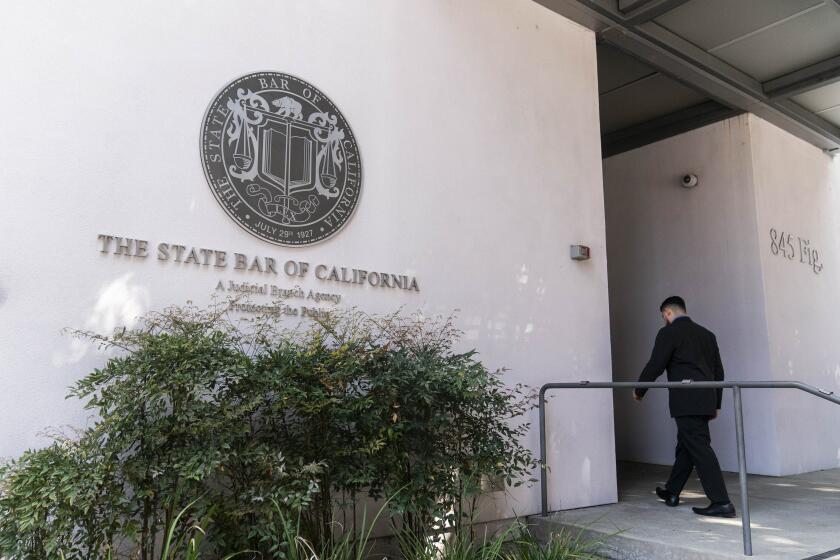Sakai Murder Probe Intrigues Both Sides of Pacific
- Share via
A few weeks after Takashi Sakai’s body was found stabbed and buried in Malibu Canyon, two Los Angeles police detectives arrived at Tokyo police headquarters with photographs of the missing murder suspect, Sakai’s 21-year-old son, Toru.
Detective Jay Rush asked his Japanese counterparts if they could distribute the photographs among police departments and newspapers in the country, the thought being that Toru Sakai may have headed to his native Japan after fleeing from his home in Tarzana. The Japanese detectives told Rush and his partner, Detective Jerry Le Frois, that they need not have bothered.
“They said we were too late,” Rush said. “They said the kid’s face was already in all the newspapers and magazines over there. Everybody already knew what he looked like.”
The murder of 54-year-old Takashi Sakai has drawn the attention of law enforcement authorities and the public on both sides of the Pacific.
Evidence-gathering in the case has gone as far as Tokyo, and an international hunt involving the FBI, Interpol, Japanese and Los Angeles police is under way for Toru Sakai.
Can’t Find Son
The young fugitive’s whereabouts are not known. Police said he may still be somewhere in the San Fernando Valley, sticking close to home and his mother, Sanae Sakai, who has been charged as an accessory in her husband’s slaying. Or he may have managed to get back to Japan, which he and his family left nearly two decades ago.
In Japan, the murder case has drawn more interest than is usually seen for an American crime. Continuing reports on the case have run in publications ranging from Japanese tabloids to Tokyo’s Yomiuri Shimbun, the largest circulation daily newspaper in the world.
Authorities said the Japanese are intrigued by the murder case, which has all the elements of a mystery novel: the victim, Takashi Sakai, a former vice president of one of Japan’s elite corporations; his wife, Sanae Sakai, 51, a member of one of Japan’s most aristocratic families, suspected of being an accessory in the murder. What’s more, the crime is believed to be patricide, a rarity in Japan where any kind of murder is itself uncommon.
Toru Sakai has been charged with conspiracy to commit murder and murder with special circumstances, which means he could be sentenced to death if convicted. A preliminary hearing for his mother on a charge of being an accessory after the fact is scheduled for April 18.
Authorities allege the slaying of Takashi Sakai was so carefully planned that it came close to going unsolved. The case moved toward a resolution after police received information from Greg Meier, a friend of Toru Sakai who has been granted immunity in the case.
“It was almost the perfect crime,” said Lonnie A. Felker, the Los Angeles County deputy district attorney assigned to the case. “They almost got away with it.”
Authorities claim the motive for the murder was money as well as the bitterness between a father and son, a husband and wife.
Takashi and Sanae Sakai were embroiled in a long-running divorce dispute in which more than $2 million worth of investments and property were at stake. Authorities said Toru Sakai took his mother’s side in the divorce, and they allege that he killed his father to ensure that he and his mother would keep all of the family fortune.
On April 14, 1985, according to records, Takashi and Sanae Sakai separated after 21 years of marriage when Takashi--or Glenn, as he was more commonly known--moved from the family’s hillside home on Braewood Drive in Tarzana to a home on Crescent Heights Boulevard near Beverly Hills.
Glenn Sakai was founder of Pacific Partners, a subsidiary of World Trade Bank, in Beverly Hills, and a respected consultant to Japanese companies looking to invest in business here.
Louis Ito, an assistant district attorney who worked on the murder investigation, said Sakai was noted for having helped negotiate a trade agreement between Isuzu and General Motors when he was a Los Angeles-based vice president with C. Itoh & Co., one of Japan’s largest trading companies. Sakai was also a board member of a variety of business and community planning organizations in Los Angeles.
“He was a prestigious man in the business communities of both countries,” Ito said.
Sanae Sakai also had a prestigious background. According to Los Angeles prosecutors and news reports in Japan, hers was one of the five top families in Japan’s pre-1945 nobility. The reports said her uncle had been the head priest of Ise Shrine--Japan’s main Shinto shrine, dedicated to the emperor’s ancestors.
A one-time model, Sanae Sakai was the 1956 winner of the Miss Heibon beauty contest in Japan. The contest was one of many sponsored by Heibon magazine in cooperation with a motion picture company. Many winners of contests later became famous movie actresses in Japan.
But years later as a resident of the United States, Sanae Sakai primarily had been a homemaker until she recently started a property management and renovation business in the Sakais’ Tarzana home.
In their years together, the Sakais had amassed real estate investments from Florida to Los Angeles to Tokyo, according to a variety of sources. There were condos or houses in West Palm Beach, Encino, Arcadia and Tarzana. In Japan there was a home worth more than $1 million and several other properties. In 1985, according to records, there was between $50,000 and $200,000 in the couple’s bank accounts. And the cars the family drove attested to success as well. Glenn Sakai drove a Mercedes-Benz. His wife and son drove Porsches.
Sued for Divorce
On the day after Christmas, 1985, Glenn Sakai sued for divorce, citing irreconcilable differences. Over the next year the divorce case moved slowly through court as the couple disputed each other’s financial demands and declarations.
By late 1986, according to court records, Sanae Sakai had asked a judge to restrain her husband from approaching, harassing or harming her or Toru. Glenn Sakai responded with a similar request aimed at his wife.
On April 17, a judge set a date for the divorce trial. But by then, Toru Sakai had already enlisted the help of Greg Meier in a plot to murder Glenn Sakai, authorities said.
According to police, prosecutors and court records, the murder occurred this way:
In early April, Sakai and Meier, both musicians and friends since San Marino High School, drove throughout the Los Angeles area looking for a place where a man could be buried and never found. They decided on a rugged and secluded hillside area just south of the tunnel on Malibu Canyon Road. On April 11, Sakai and Meier went back to the spot and dug a grave.
During the next week Sakai collected a metal bar, a pair of handcuffs, a roll of duct tape and a knife. He also told Meier to expect a phone call on the day the slaying would take place. After receiving the call, Meier was to go to a vacant home on Crescent Drive in Beverly Hills.
On April 20, Toru Sakai called his father at his Beverly Hills office and asked the older Sakai to meet him at the Beverly Hilton Hotel to discuss a personal problem. His father agreed but before Toru went to the hotel to meet him, he made the prearranged call to Meier and drove to the Crescent Drive home.
Once there, Toru handed Meier the metal bar and told him to wait for Toru to return with his father. Meier was to strike the older Sakai with the bar when he walked in.
Toru Sakai left and met his father as planned at the Beverly Hilton. At the hotel he persuaded his father to go with him to the Crescent Drive home. Once inside the home, authorities allege, Glenn Sakai was knocked unconscious by Meier and stabbed to death by Toru. The body was then loaded in Toru’s Porsche and taken to the grave in Malibu Canyon.
From the start, police suspected foul play. Glenn Sakai disappeared without a word to anyone, had a girlfriend waiting for him at home and a full appointment calendar at the office the following day.
“It was quite evident this man had absolutely no reason to disappear,” said Lt. Ron Lewis, who supervised the investigation.
Car Found at LAX
Three days after the disappearance, police found Sakai’s Mercedes-Benz parked at Los Angeles International Airport. A box of personal and financial records that Sakai was said to have kept with him at all times was missing. Detectives could find no record of Sakai having taken a flight from the airport.
Authorities said the investigation quickly focused on Sakai’s family and, on Dec. 3, investigators went to the Sakai home to search for family financial records, correspondence and other evidence to build a murder case. Investigators will not say what they found, but Sanae Sakai was questioned and released that day; her son was arrested on suspicion of murder.
However, Toru Sakai was released from jail three days later after the district attorney’s office determined there was not enough evidence--authorities had not even found a body--against the younger Sakai to warrant a murder charge.
“We had thought there was a good chance that by arresting him we would be able to gain significant evidence to charge him,” Lewis said. “Unfortunately, we fell short.”
Felker added: “There are no feelings of mistakes. We don’t feel badly about letting him go. It was part of the investigation.”
Toru Sakai was put under surveillance after his release, but he could not be watched full time because of a lack of officers, police said.
By early February, Meier emerged as a prosecution witness against Toru Sakai. Felker would not say how detectives brought Meier forward as a witness. Meier was granted immunity from prosecution in exchange for key information and testimony about the slaying.
“I’m reluctant to give anybody immunity,” Felker said. “But sometimes it is necessary when it is a question of getting none or getting one out of two or three suspects in a case.”
Police will not say whether Meier led them to Glenn Sakai’s body in Malibu Canyon on Feb. 10. But they kept the discovery secret while arrest warrants were prepared and additional evidence gathered. Detectives learned Toru Sakai’s Porsche had been sold to a company that shipped the car to Japan. They later examined the car for blood and other evidence. Detectives say they found no blood in the car, but would give no other details.
On Feb. 25, police returned to the Sakai home to arrest the dead man’s wife and son. Only Sanae Sakai was home. She was arrested and charged as an accessory. Authorities allege that, at a minimum, she learned of her husband’s murder and aided her son afterward.
Police said an investigation of her alleged involvement in the slaying is continuing, though she has denied any involvement.
“Mrs. Sakai asserts her innocence,” said her attorney, Scott S. Furstman. “She absolutely knew nothing.”
As for Toru Sakai, police said they have not determined when or whether he left the Los Angeles area.
Staff writer Sam Jameson in Tokyo contributed to this report.
More to Read
Sign up for Essential California
The most important California stories and recommendations in your inbox every morning.
You may occasionally receive promotional content from the Los Angeles Times.









